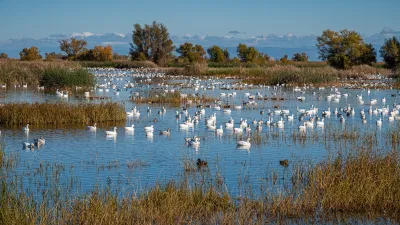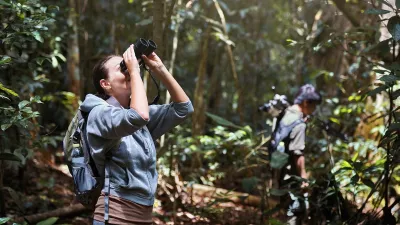The term Green Urbanism keeps showing up unexpectedly in newspaper articles, conference session titles, blog posts, and casual conversation. While there is an innate, intuitive sense of the meaning, green urbanism may also seem as elusive as it is evocative. Having given this topic a fair amount of thought over the past several years, I, and my colleague and collaborator Ted Bardacke, arrived at the following working definition: green urbanism: the practice of creating communities mutually beneficial to humans and the environment
The term Green Urbanism keeps showing up unexpectedly in newspaper
articles,
conference session titles, blog posts, and casual conversation. While
there is an innate, intuitive sense of the meaning, green urbanism may
also
seem as elusive as it is evocative. Having given this topic a fair
amount
of thought over the past several years, I, and my colleague and
collaborator Ted
Bardacke, arrived at the following working definition:
green urbanism: the
practice of creating communities mutually beneficial to humans and the
environment
This practice builds on the seminal efforts of Olmsted, Ian Mcharg, Jane
Jacobs, Anne Spirn, Michael Sorkin, and many others, often taking many
shapes
and directions. But the questions are strikingly similar.
How do you design a neighborhood or a city like an ecosystem? What is
the right benchmark for sustainability? How do you integrate the many
components of urbanism to generate the synergies essential to creating a
sustainable place?
Our ability to answer these questions and to rise to the subtle but deep
challenge posed by bringing together the words "green" and
"urban" is a function of how we see our place in the world. By
understanding that people are part and parcel of nature, and have never
been
external to the ecological flows of the natural world, we can become
reconnected to nature, shift how we perceive our relationship to the
environment, and reevaluate what we want – and what we need – from that
most
wondrous of human inventions, the city.

Alabama: Trump Terminates Settlements for Black Communities Harmed By Raw Sewage
Trump deemed the landmark civil rights agreement “illegal DEI and environmental justice policy.”

Study: Maui’s Plan to Convert Vacation Rentals to Long-Term Housing Could Cause Nearly $1 Billion Economic Loss
The plan would reduce visitor accommodation by 25% resulting in 1,900 jobs lost.

Planetizen Federal Action Tracker
A weekly monitor of how Trump’s orders and actions are impacting planners and planning in America.

Wind Energy on the Rise Despite Federal Policy Reversal
The Trump administration is revoking federal support for renewable energy, but demand for new projects continues unabated.

Passengers Flock to Caltrain After Electrification
The new electric trains are running faster and more reliably, leading to strong ridership growth on the Bay Area rail system.

Texas Churches Rally Behind ‘Yes in God’s Back Yard’ Legislation
Religious leaders want the state to reduce zoning regulations to streamline leasing church-owned land to housing developers.
Urban Design for Planners 1: Software Tools
This six-course series explores essential urban design concepts using open source software and equips planners with the tools they need to participate fully in the urban design process.
Planning for Universal Design
Learn the tools for implementing Universal Design in planning regulations.
Caltrans
Smith Gee Studio
Institute for Housing and Urban Development Studies (IHS)
City of Grandview
Harvard GSD Executive Education
Toledo-Lucas County Plan Commissions
Salt Lake City
NYU Wagner Graduate School of Public Service






























